Symmetry of Diamond Facets - Determines the diamond sparkle
Symmetry of diamond facets is one of the determining factors for cut
quality of diamond. In order to have maximum sparkle, facets of diamonds
must be perfectly symmetrical. When viewed through 10X magnification
lens, one can easily study the symmetry of facets.
On this page, you will learn about following symmetry features in detail:
- Girdle Shape
- Table Shape and Table Edges
- Tilt of the Table
- Centricity of the Table
- Centricity of the Culet
- Sharpness of the Facet Edges and Facet Junctions
- Alignment of Crown Facets and Pavilion Facets
- Symmetry of Girdle
These features are evaluated on the basis of their visibility, frequency and amount to which these affect the brilliance of diamond.
But before going further please go through Parts of Round Brilliant Cut and Diamond Facets
in order get your basics right.
Now, let’s learn about each symmetry feature in detail.
Girdle Shape
Ideally, when viewed from top, girdle of diamond should appear a uniform circle. However, at the time of bruiting of rough stone, girdle formed may come out to be a slightly distorted circle.
If the deviation from circular shape is more than 2% then it results into loss of brilliance and affects the symmetry of diamond and cut quality of diamond.
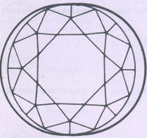
Following are the reasons behind distorted girdle shape:
- Unusual shape of original rough stone.
- In order to retain maximum carat weight, diamond cutter may compromise on girdle shape.
- There may be damage or heavy inclusions on one side of a diamond and in order to retain maximum diamond weight, cutter may remove only the damaged portion leading to distorted circular girdle.
Table Shape and Table Edges
In a round brilliant cut diamond, the table facet should have a perfect octahedral shape. But, sometimes one or more blunt table edges are observed. Any displacement in facet arrangement can distort the shape of the table of diamond.
Lines of table edges should be regular and opposite table edges should be parallel to each other. If the table edges are not straight but wavy, then the diamond cannot be considered symmetrical as table facets also affect adjoining facets.
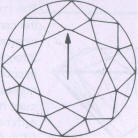
Tilt of the Table
Ideally, table plane and girdle plane should be parallel to each other. This results in equal crown height when diamond is viewed sidewards from all directions. Any tilt in the table can cause uneven crown height.
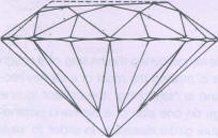
When you get different crown height while measuring from different direction, it means that table is tilted.
Generally the tilt in a table is caused due to original shape of the rough diamond itself or due to removal of inclusion near the table surface.
Centricity of the Table
Center of the table should be exactly above the culet and the center of girdle plane. If this is not the case then it’s called Eccentric table. If the displacement of table center is more than 2% then it leads to different sizes of crown facets. This affects the dispersion of incident light and brilliance of diamond.
Centricity of the Culet
Culet is the smallest facet in a brilliant cut. Ideally, the culet of diamond should lie on the line perpendicular to the girdle plane and passing through the center of table and center of girdle plane. If this is not the case then it’s called Eccentric culet.
Eccentric culet can be easily seen through side or when looked through the table of diamond. The eccentric culet is formed due to:
- Non-uniform inclination of pavilion facets. If the pavilion angle is not same in all directions then culet gets displaced out of position.
- The off-centering can also be result of uneven sizes of the facets.
A culet displaced up to 2% is still acceptable and can be termed as “very good”. But if the displacement is noticeable than it can lead to whole diamond appear distorted.
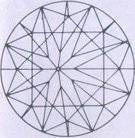
Note: Centricity of Table and centricity of Culet is measured w.r.t position of center of Girdle.
At times it seen that culet and table are displaced in same direction or they are displaced in opposite directions.
Sharpness of the Facet Edges and Facet Junctions
In a very good cut diamond, facet edges (line of intersection of 2 facets) and facet junctions (point of intersection of more than 2 facets) must be sharp and show no sign of any abrasion.
At times, the main facets of crown and pavilion are truncated (facets having abrupt end) at the girdle and it affects the symmetry of facets. Also, there should not be any facet displacement with respect to each other as they affect the symmetry considerably.
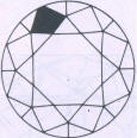 |
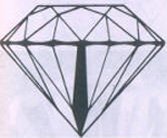 |
| Truncated Crown Main Facet | Truncated Pavilion Main Facet |
Alignment of Crown Facets and Pavilion Facets
Intersection points of the kite facets of the crown and pavilion main facets of the pavilion should lie on girdle and should be exactly opposite to each other. Also, the edges of upper girdle facets and lower girdle facets should lie on girdle.
Similarly, junction of star, upper girdle and crown facets should be clearly defined. There should be perfect alignment and no sideways displacement with respect to one another.
 |
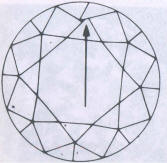 |
| Assymmetric Pavilion Facet | Displaced Crown Facets Junction |
The facet alignment may not be given enough attention while cutting small sized diamonds of commercial quality. This is because it may not be profitable to spend much time in getting right alignment. But, in high quality small sized diamonds, due attention should be given for facet alignment. Otherwise it may adversely affect the cut quality and lead to uneven girdle and reduce the brilliance of diamond.
Symmetry of Girdle
A symmetrical girdle has regular thickness throughout the stone in a plane parallel to that of the table of stone. The intersection of the kite facets of the crown with the pavilion main facets of the pavilion should lie on girdle and should be exactly opposite to each other, also upper girdle facets should meet the lower girdle facets.
A girdle cannot be considered symmetrical if it:
- Has a wavy course with comparison to table of diamond.
- If the thickness of girdle is not same throughout the diamond.
- If the girdle is either completely or partially knife edged.
- Has unequal thickness throughout the diamond.
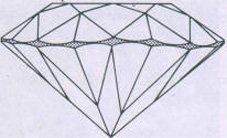 |
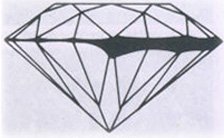 |
| Wavy Girdle | Irregular Girdle |
Return from Symmetry of Diamond Facets to Cuts of Diamond page
Return from Symmetry of Diamond Facets to Diamond Jewelry Homepage
I hope you'll not mind sharing this on Twitter, Facebook and with everyone else :)
Feel free to share if something is in your mind and want it to be covered on this site.
My Newsletter
Did you liked this article? Sign-up my FREE weekly newsletter and I'll send you more awesome new additions on this website along with latest jewelry happenings around the world, and download my Jewelry Design Album for FREE!
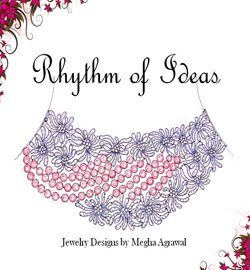 |
|


